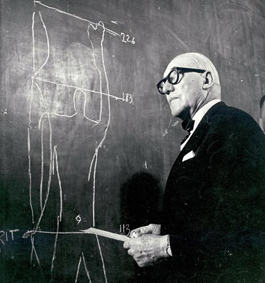
From the birth of Le Corbusier, 125 years will pass on Saturday
 |
His entire life was captivated by the precision and functionality of various machines, cars, and ships. His fascination had its roots in Le Corbusier's original profession; he trained as a watchmaker. This craft had a tradition not only in his native region (he was born in the Swiss town of La Chaux-de-Fonds) but also in his family. However, he could not pursue it further. Since childhood, Charles-Édouard Jeanneret, which was the architect's real name, had very weak eyesight, and by his thirties, he was even blind in one eye.
This handicap caused problems for Le Corbusier, but it could not prevent him from active work. He completed a total of 75 buildings on several continents (his first villa at just 19 years old), designed dozens of urban studies, wrote over 40 books, published several magazines, created hundreds of drawings and paintings, and notably made his mark as a furniture designer. His famous Chaise Longue lounge chair, for example, has copies that now sell for tens of thousands of crowns.
Le Corbusier, who chose his pseudonym after his maternal grandfather and first used it in 1923 (by which time he was already working in Paris), gradually created five points or building elements that became the foundation of his architecture. These included pilots, roof gardens, open floor plans, strip windows, and free facade layouts. The term "Free Plan - Plan libre," which designates Le Corbusier's concept, was derived from this freedom of layout and facade arrangement.
The designer highlighted bare concrete as a unique material, and he placed emphasis on greenery, light, and space. He considered high-rise construction as the only viable solution to combat the "overcrowding" of cities. His first major realization in this direction was Le Corbusier's design for the multi-story housing complex Unité d'Habitation (1952) with 337 residential units in Marseille. Unlike earlier opinions, he connected various functions - living, shopping, leisure, and children's facilities - in a single building.
In addition to several of these collective houses (a building of similar design by Czech architects also stands in the northern Bohemian town of Litvínov), or what Le Corbusier called "vertical garden cities," many other buildings made it into textbooks. These include the chapel in Ronchamp, France, the La Tourette monastery complex near Lyon, the La Roche house in Paris, the Savoye villa in Poissy, the Centrosojuz building in Moscow, the Swiss pavilion in Paris, houses in Stuttgart, Germany, or the buildings in Chandigarh, India.
Le Corbusier's relationships with the Czech Republic are also noteworthy, where functionalism found fertile ground. The architect successfully lectured several times in Prague. He was impressed by the Veletržní Palace and was particularly fascinated by the urban design of Baťa's Zlín - he even created a building plan that, however, was never realized. On the other hand, he assessed the appearance of Karlovy Vary as "a gathering of whipped cream cakes." Some local architects also worked in his studio, the first of whom was reportedly Vladimír Karfík.
Sociologist of urbanism or apostle of modernity, as Le Corbusier was sometimes called, is occasionally accused of instigating mass housing construction in the 1960s to 1980s with his theories of living in Radiant Cities, which led to alienated environments. However, modernity specialists dispute this. The architect, who died of a heart attack at sea on August 27, 1965, has many followers. He is buried next to his wife in Roquebrune, France, a country that became his second home.
The English translation is powered by AI tool. Switch to Czech to view the original text source.
0 comments
add comment











